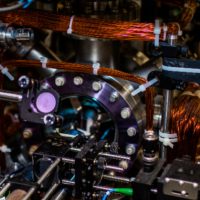News
Direct Laser Cooling Rubidium Atoms
A group at MIT led by Vladan Vuletic has recently created a Bose-Einstein Condensate (BEC) of rubidium atoms with a new method, direct laser cooling. Many researchers have attempted this elusive goal in the past, but due to various complications resorted to reaching BEC through evaporation instead. Compared to cooling through evaporation, laser cooling is fast faster and more efficient, resulting in reduced constraints for the experimental setup.
Achieving BEC, where a substantial fraction of a collection of identical bosonic trapped atoms all occupy the same, lowest energy quantum state available, requires both very low temperatures and high atom number densities. At low temperature, the atoms’ quantum nature becomes more apparent since each atom’s quantum wavefunction can then spread out in space. Packing the atoms close together at high density then allows nearby atoms’ wavefunctions to overlap, giving rise to BEC by further enhancing the probability of atoms being found near each other due to the bosonic quantum statistics.
Laser cooling of atoms, where a set of lasers are carefully positioned and tuned to slow down the motion of the atoms by kicking them with photons, is commonly used to create cold clouds of atoms. In the past, however, it has proven difficult to use laser cooling to simultaneously create a sample of atoms with high enough density for BEC, since the laser light can then photoassociate neighboring atoms into molecules which leave the atom trap.
The Vuletic group found that they could dramatically reduce these atoms losses by deliberately choosing the energy of the pumping laser to mismatch the amount of energy required to form molecules. Combined with a carefully optimized method of Raman cooling, this allowed them to produce a cold cloud with a density high enough to create a moderately sized BEC in about 1 second of cooling. Such a short duration is already on par with the very best evaporation techniques, which were optimized for speed, highlighting the potential of the new laser cooling technique.
The laser cooling method should be applicable to other species of atoms in the future, as well as to cooling of molecules.
